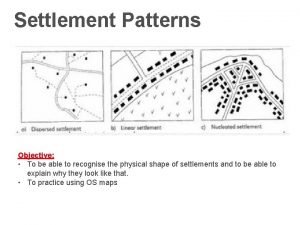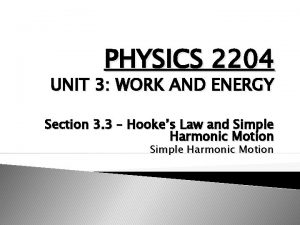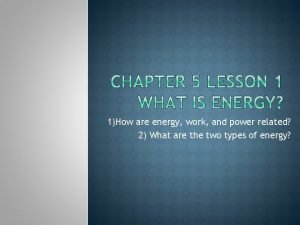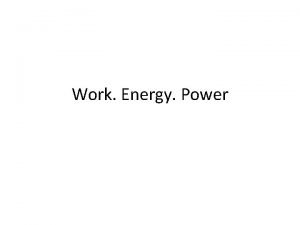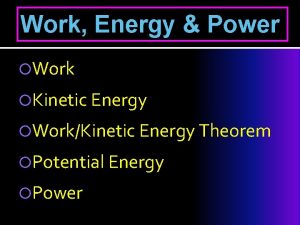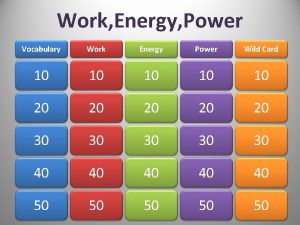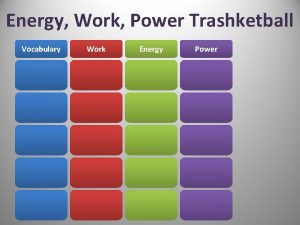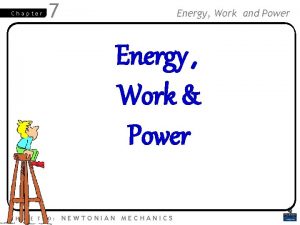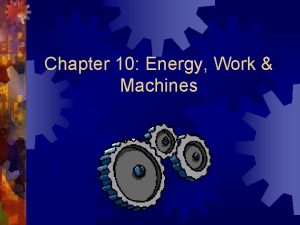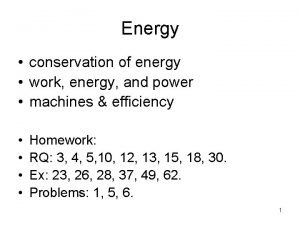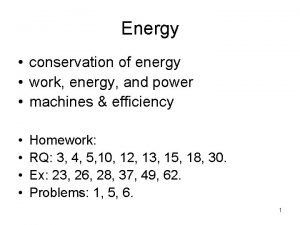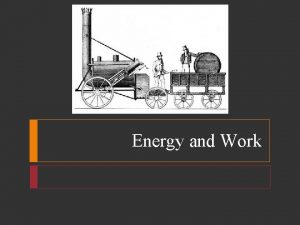Chapter 8 Work Power Energy WORK ment PHYSICAL





















- Slides: 21

Chapter 8 Work Power & Energy

WORK � � � ment". PHYSICAL DEFINITION OF WORK "Work is said to be done if a force causes a displacement in a body in the direction of force". OR "The work done by a constant force is defined as the product of the component of the force and the displacement in the direction of displacement. " MATHEMATICAL DEFINITION "Work is the scalar product of force and displacement". OR "Work is the dot product of force and displace.

DERIVATION FOR WORKDONE In the above figure. Force “F” divided into two components vertical Fy and horizontal Fx. is the angle between them. So the dot product of Fx and displacement “S” is given by:

Derivation � � � W = Fx. S _______ (i) We know that, Cos = base / hyp, Cos = Fx / F Put this Fx = F Cos in equation (i) W = F Cos S W = FSCos The above equation is called work done equation. Where Cos is an angle between F and S. � Work is a scalar quantity.

UNIT OF WORKS • In S. I system: Joule (j) • In C. G. S. system: Erg • In F. P. S. system: ft X lb

CATEGORIES OF WORK � (i) POSITIVE WORK: If force and displacement are in the same direction, work will be positive or if q = 0 or q < 90°

ZERO WORK � � If force and displacement are perpendicular to each other, work will be zero. i. e. since q = 90° Work = 0 as Work = Fd Cos q Work = Fd Cos 90° Work = (F)(d)(0) Work = 0

NEGATIVE WORK � If force and displacement are in the opposite direction, work will be negative. since q = 180° Work = - ve as Work = Fd Cos q Work = Fd Cos 180° Work = (F)(d)(-1) Work = -Fd

ENERGY � "The ability of a body to perform work is called Energy". � A body cannot perform work if it does not posses energy. A body cannot perform work more than the amount of energy. � It is a scalar quantity. � UNITS OF ENERGY � (i) Joule (ii) Calorie [NOTE: 1 Calorie = 4. 2 joule. ] (iii) KWatt-Hour

TYPES OF ENERGY � There aree numerous types of energy such as: Heat Energy Light Energy Sound Energy Nuclear Energy Chemical Energy Electrical Energy Solar Energy Wind Energy Kinetic Energy Potential Energy etc.

POWER "The rate of work done of a body is called Power". � AVERAGE POWER � Average power of a body doing work is numerically equal to the totla work done divided by the time taken to perform the work. � MATHMATICALLY Power = Work done/time Power = Work/t but [work = Fd] therefore Power = Fd/t � UNITS OF POWER � (i) watt [1 watt = 1 joule/sec ] (ii) Kilo watt [1 Kw = 1000 watt] (iii) Mega watt (Mw) [1 Mw = 106 watt] (iv) Horse power [1 Hp = 746 w] �

POTENTIAL ENERGY � INTRODUCTION Energy stored by a body by any means is called "Potential Energy". DEFINITION "The energy stored by a body due to its position in gravitational field is known as ‘Gravitational Potential Energy’".

FORMULA � Consider a body of mass "m" placed at a height of "h" from the surface of earth. Force = Weight = W but displacement (d) = h Work done = Fd OR Work done = Wh [but W = mg] work done = mgh We know that the work done in lifting the body is stored in the body in the form of Potential Energy. Thus

KINETIC ENERGY "Energy posses by a body by virtue of its motion is referred to as ‘Kinetic Energy’". � FORMULA � K. E. = 1/2 mv 2 � Kinetic energy depends upon the mass and velocity of body. If velocity is zero then K. E. of body will also be zero. � Kinetic energy is a scalar quantity like other forms of energies.

DERIVE: K. E = 1/2 mv 2 � PROOF: Consider a body of mass "m" starts moving from rest. After a time interval "t" its velocity becomes V. If initial velocity of the body is Vi = 0 , final velocity Vf = V and the displacement of body is "d". Then

Mathematical � � � First of all we will find the acceleration of body. Using equation of motion 2 a. S = Vf 2 – Vi 2 Putting the above mentioned values 2 ad = V 2 – 0 a = V 2/2 d Now force is given by F = ma Putting the value of acceleration F = m(V 2/2 d) As we know that Work done = Fd Putting the value of F Work done = (mv 2/2 d)(d) Work done = m. V 2/2 OR Work done = ½ m. V 2 Since the work done is motion is called "Kinetic Energy" i. e. K. E. = Work done OR K. E. =1/2 m. V 2.

LAW OF CONSERVATION OF ENERGY � � � According to the law of conservation of energy : "Energy can neither be created nor it is destroyed, however energy can be converted from one form energy to any other form of energy" INTER CONVERSATION OF ENERGY: Suppose a body having mass “m” placed at a height of “h” in the position of rest as shown in figure,

Mathematical � � � � � � So, its kinetic energy is zero. So its potential energy is. mgh Total energy = PE + K. E E = mgh + 0, E = mgh Suppose the body is released from the height “h”, Now the height of body. BC = h – x In this case we use equation of motion to calculate velocity. AT POSITION “A” Vi = 0, S = x, Vf = Vi, a = g Vf 2 - Vi 2 = 2 a. S 2 gx = V 2 - 0 V 2 = 2 g x AT POSITION “B” K. E = ½ mv 2 _____ 1 Put the value of V 2 in equation 1. K. E = ½ m 2 gx K. E = mgx Potential energy at Point “B” P. E. = mg (h-x) So total energy at point “B” is, T. E = K. E + P. E. T. E = mgx + mg (h-x), T. E = mgx + mgh – mgx T. E = mgh

SHOW THAT THE MOTION OF A SIMPLE PENDULUM IS ACCORDING TO THE LAW OF CONSERVATION ENERGY � We know that the motion of the bob of a simple pendulum is simple harmonic motion. Here we have to prove that the energy is conversed during the motion of pendulum. Proof: Consider a simple pendulum as shown in the diagram.

Energy � � Energy Conservation At Point ‘A’ At point ‘A’ velocity of the bob of simple pendulum is zero. Therefore, K. E. at point ‘A’ = 0. Since the bob is at a height (h), Therefore, P. E. of the bob will be maximum. i. e. P. E. = mgh. Energy total = K. E. + P. E Energy total = 0 + mgh Energy total = mgh This shows that at point A total energy is potential energy. Energy Conservation At Point ‘M’ If we release the bob of pendulum from point ‘A’, velocity of bob gradually increases, but the height of bob will decreases from point to the point. At point ‘M’ velocity will become maximum and the height will be nearly equal to zero. Thus , K. E. = maximum = 1/2 m. V 2 but P. E. = 0. Energy total = K. E. + P. E Energy total = 1/2 m. V 2 + 0 Energy total = 1/2 m. V 2 This shows that the P. E. at point is completely converted into K. E. at point ‘M’.

Energy � � Energy Conservation At Point ‘B’ At point M the bob of Pendulum will not stop but due to inertia, the bob will moves toward the point ‘B’. As the bob moves from ‘M’ to ‘B’, its velocity gradually decreases but the height increases. At point ‘B’ velocity of the bob will become zero. Thus K. E. at point ‘B’ = 0 but P. E. = max. P. E. = mgh. Energy total = K. E. + P. E. Energy total = 0 + mgh Energy total = mgh This shows that at point B total energy is again potential energy. CONCLUSION Above analysis indicates that the total energy during the motion does not change. I. e. the motion of the bob of simple pendulum is according to the law of conservation of energy.
 Settlement paterns
Settlement paterns Ment morpheme
Ment morpheme Word formation happy
Word formation happy Go towww.menti.com and use the code
Go towww.menti.com and use the code Adding ment
Adding ment Translatenslator
Translatenslator Zonealarm free firewall vous ment
Zonealarm free firewall vous ment Noun ment
Noun ment Www.menti.comcom
Www.menti.comcom Pneumon o medical term
Pneumon o medical term Tv tain
Tv tain Chapter 4 work and energy section 1 work and machines
Chapter 4 work and energy section 1 work and machines Draw power triangle
Draw power triangle Energy energy transfer and general energy analysis
Energy energy transfer and general energy analysis Energy energy transfer and general energy analysis
Energy energy transfer and general energy analysis 0kei0
0kei0 Work, power and energy activities
Work, power and energy activities Unit of resistivity
Unit of resistivity Physics 2204 unit 3: work, power, energy
Physics 2204 unit 3: work, power, energy Work and power definition
Work and power definition How are energy work and power related
How are energy work and power related Work power energy and machines
Work power energy and machines
